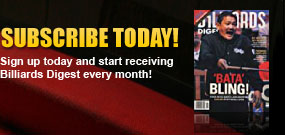|
Adapt to the Equipment May 2014
Iíve talked in the past about getting acquainted with equipment away from your home, or your ďhomeĒ billiard club. When I was 15 and playing all the time, I remember reading an article in Billiards Digest which said that in order to become a true master of the table, you had to learn how to adapt to different equipment.
I took that advice literally. For the next few years I made it my business to go to four different pool halls every week. I went to one where the tables played long, one where they played short, one where the tables were lightning fast, and one that played normally. I learned a lot doing that, and within a year I understood the difference between long and short, fast and slow.
Now it takes me only a few racks to make the proper adjustments on any table. Thatís a huge advantage. A lot of pros know how to adjust, but there are still pros out there who, given certain types of equipment, just canít adjust.
I always based my adjustments off the standard kick shot where you put the cue ball in one corner and an object ball in the other, and you use running English to send the cue ball between the two diamonds on the long rail and three rails to pocket the object ball. On a normal table, if you hit it between the diamonds it will go right in. At one of the other rooms, the table ran so long that I had to hit just before the side pocket in order to adjust to how much the angle was lengthened off the third rail. At another room, the table ran so short that I had to hit just before the corner pocket at the top of the table. Additionally, if the table runs fast or slow, you have to adjust the speed of your stroke.
To make the proper adjustments, I developed a system for myself. If Iím playing on a table that runs long, I use a half-tip to three-quarters-tip less spin and the ball will run normally. For tables running short, I use additional spin. I keep shooting the shot, and move my aim point a half-inch at a time until I get the results I want. Now I know that on any shot using that spin, I have to aim one inch or two inches further or shorter than normal to get the proper result. I try to use the same spin as my gauge so that I get consistent information.
Remember, the key is to get the table to your normal. This information is critical not only for rail-first shots, but also for playing position off a rail with spin.
|





